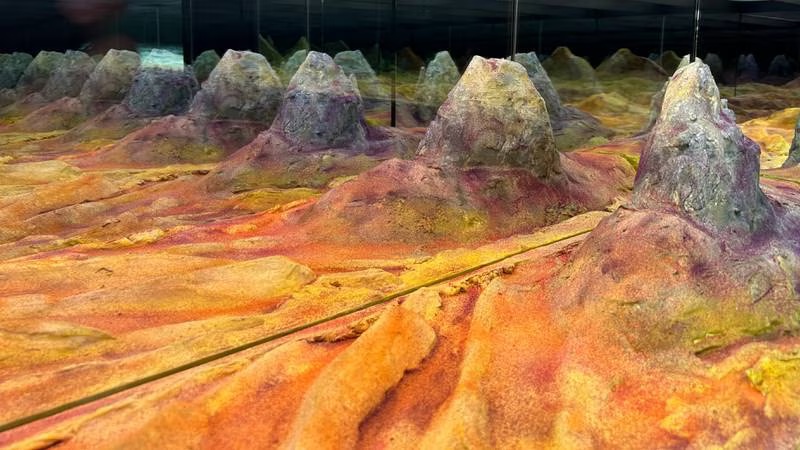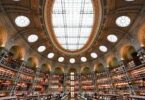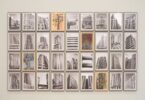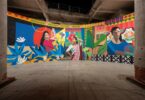Razmig Bedirian
From small, infinitely-reflected landscapes to colossal installations that touch upon the tragedies of climate change, Blane De St Croix’s work emerges from the environmental realities we can no longer ignore.
His solo exhibition at NYU Abu Dhabi Art Gallery comes at an opportune moment. As the UAE gears up for the upcoming Cop28 summit, Horizon offers an awe-inducing study of landscapes, both local and foreign.
In some works, such as the ones inspired by the UAE’s sabkhas, De St Croix pays tribute to the magnificence of the natural world. In others, he evokes the adverse traits of our relationship with the environment, touching upon political currents that have devastated ecosystems.
Horizon, however, begins on a more whimsical note.
:quality(70)/cloudfront-eu-central-1.images.arcpublishing.com/thenational/GHJEEJ35E5DFXPWVVL4GKZOS7M.jpg)
A model train runs along a track that swerves across the gallery space, with each of its 39 cars bearing landscape sculptures inspired by the places that De St Croix has studied. These include the Arctic, the Gobi Desert, the bayous of Florida and the forests of Haiti.
More than half the cars, however, are dedicated to the places he encountered during his visit to the UAE. Through its choice of medium, Transcontinental Divide, which has been a growing work in progress since 2020, also conveys the transformation of trains from an environmental problem to a more conscientious mode of transportation.
“Trains are associated with the Industrial Revolution, which marks the beginning of the Anthropocene [when humans began to have a significant impact on the Earth’s ecosystems],” says Maya Allison, executive director of NYU Abu Dhabi Art Gallery and the university’s chief curator.
“In many ways, they represent the beginning of our downfall. But today, trains are more fuel efficient than any other form of transportation. They mark the problem, but they also offer a possible solution.”
:quality(70)/cloudfront-eu-central-1.images.arcpublishing.com/thenational/E3KLWT67BRF45DMXC562DIQ5QY.jpg)
A series of ink collages then begin to depict – in visuals that verge on abstraction – environmental catastrophes in specific parts of the world. Louisiana Bayou Cypress, composed in 2018 with ink on paper and digital archival prints, shows a forest of leafless, branchless cypress trees that were killed as industrial companies carved out a channel for their barges, causing saltwater from the nearby bayou to flood the marsh, effectively killing the flora.
Tree Line: Haiti/Dominican Republic Border, on the other hand, offers a bird’s-eye view of the border between the two Caribbean countries. While the trees grow lush in the Dominican Republic, the Haitian side is depleted of forestry.
“He makes the drawings, prints them, and cuts them up into collages then he draws on them again,” Allison says. “This is looking at the border between Dominican Republic and Haiti. These two countries [have] such different histories. Spain colonised the DR and France colonised Haiti. The French brought in 10 times more slaves than the Spanish.
“When Haiti rebelled, they made a treaty with France for their sovereignty. They owed France something like 90 million francs, for the cost of the slaves. In essence, they were buying their own freedom. But to pay France back meant the deforestation of their country. Now we’re seeing that every time a storm comes through, the country is just decimated, because there is nothing to anchor it to the ground.”
:quality(70)/cloudfront-eu-central-1.images.arcpublishing.com/thenational/6KTVD5HW4NH6VESRIAIDZ77MUQ.jpg)
The piece, as with most of the works within Horizon, show how deeply intertwined human behaviours are with ecological disasters. However, the sculptural works that follow take a step back from the grave. Instead, they are homages to natural landscapes within the UAE, which the artist encountered during his residency.
The country’s deserts and salt flats are recreated as dioramas of recycled foam, paper pulp, acrylic paint and coloured sands. Displayed in glass, with mirrored back and sides, the landscapes repeat towards the infinite. Despite their small size, they instil a feeling of enormity and endlessness, similar to experiencing the landscapes in real life. The sculptural pieces are named after the places they are inspired by, from sites in Sharjah’s Mleiha region, to the Liwa desert and salt flats of Abu Dhabi.
“[De St Croix] used children’s sand of different colours,” Allison says. “He was trying to get the colour of how it looks at sunrise or sunset. He’s not trying to render it one to one. It’s more of an impression than a direct rendering.”
From this point on, De St Croix’s installations start incrementally growing in scale. These include ink collages, similar to the preceding work but larger, drawn from the glaciers and arctic shorelines in the Svalbard Archipelago. They are exhibited around a sprawling black landscape made of cotton pulp, metal dust and carbon. Lava Bed is from the artist’s study of Hawaii’s shield volcano Kilauea, which became active as the artist was visiting it in 2015.
“He sculpts it and dries it with fans to make it crinkle up, which is the opposite of what you would normally do with paper,” Allison says about De St Croix’s approach to working with cotton pulp.
:quality(70)/cloudfront-eu-central-1.images.arcpublishing.com/thenational/6FG4IM7SSVHQXHJQXW77QQWIYQ.jpg)
Examples from De St Croix’s unique crate-hoisted landscapes are also on display. The title of the series, En Plein Air, is a nod to the Impressionists’ description of painting outdoors. The pieces have been sculpted on site, in places such as Svalbard and the Gobi Desert, and use natural materials from these areas. The works are a metaphor for how we carry landscapes we’ve visited within us.
“What he did was he made these crates that could pack flat and he would take in a suitcase, and on site he is sculpting to match the landscape,” Allison says. “So this actually has bits of Gobi Desert dirt and grass.”
In the final stretch of the exhibition, De St Croix’s installations take on colossal forms.
In High Peaks: Himachal (Snow Mountain), which has been commissioned by the NYU Abu Dhabi Art Gallery, towering forms on pedestals are presented that allude to the Himalayan landscape. De St Croix developed the work after visiting in 2015 to conduct field research. The dripping forms of the mountains are an artistic expression of the fact that the Himalayan glaciers are melting quicker than previously thought. At the current rate, 80 per cent are expected to be lost by the turn of the century. This will trigger a domino effect that will be calamitous to billions around the world.
“It will flood that half of the hemisphere, and completely changed the whole ecosystem of how people live, how animals survive, but also water levels,” says Allison. The piece, she says, is also the result of conversations De St Croix had with a group of scholars at NYU who are working on a project about Himalayan water.
“They’re not scientists. They’re actually mostly humanists, historians who work on the history of the ecology or human environmental history, as well as sociologists,” says Allison. “They were like ‘you really have to make a piece about the Himalayas’. And so he went back to this project.”
:quality(70)/cloudfront-eu-central-1.images.arcpublishing.com/thenational/I56ZBX7XIBF6RDKYIA5GTA32OM.jpg)
A more involved collaboration with an NYU faculty member came in the largest piece in the exhibition, and one of its most viscerally impactful. Salt Lake Excerpt, UAE fills an entire gallery space within the exhibition. An extensive, enveloping landscape work that pays tribute to the local sabkhas, inviting viewers to walk around it, peeking at the pockets of water designed within the sculpted terrain. The work is made from fabric as well as plastic flakes, which were rendered from 50,000 locally sourced plastic bottles by the Dubai recycling company DGrade.
What gives the installation its enveloping feel is the lighting and sound, which have been meticulously designed to change depending on where you view the artwork from.
Salt Lake Excerpt, UAE was developed with theatre artist and NYUAD faculty Joanna Settle. It was created after a series of excursions to the salt flats in the Emirates.
“[Settle] has got this record of doing formal experiments in theatre, opera and cabaret,” says Allison. “They’ve been working on it for the last year. The lighting and the sound is a big part of what she brought to the project. The sound was designed by Joao Menezes. He’s also on our faculty here. This is a recording he made of tectonic plates shifting under the earth in California. He’s altered and developed it under Joanna’s direction.”
The larger-than-life artworks within Horizon implore us to bring sobriety to our relationship with the Earth. While international government conferences such as Cop28 may feel like an inaccessible affair to many, Horizon shows how their resolutions and policies do not exist in a vacuum.
It underscores their importance to better our planetary health, which could otherwise spell out environmental disasters that will affect us on an individual level. But it is not all grim and grave, Horizon also reminds us that we must be conscientious of the planet’s health not just for our own sake, but also to preserve the awe-inspiring and inimitable art of the natural world.







